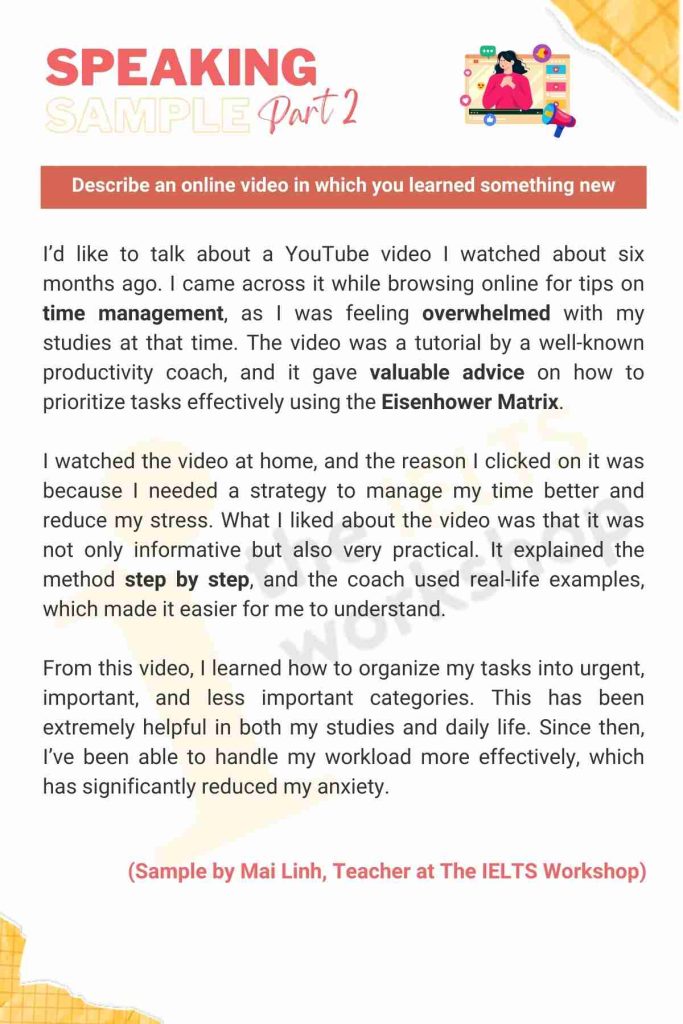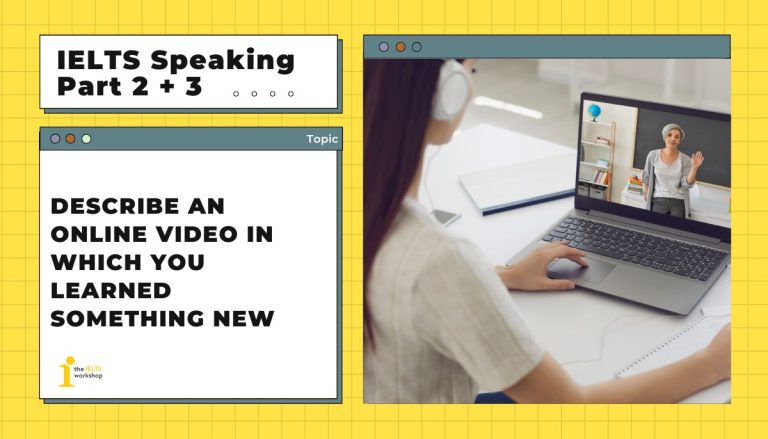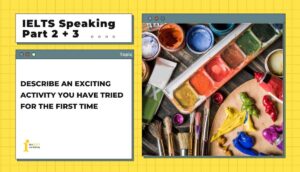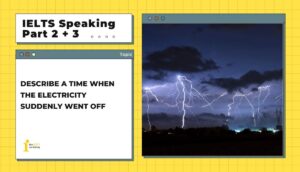Cùng The IELTS Workshop tham khảo cách giải Topic IELTS Speaking Part 2 chủ đề: “Describe an online video in which you learned something new” qua bài mẫu của cô Mai Linh. Đừng quên take note lại từ vựng và các cấu trúc ghi đểm bạn nhé.
Part 2: Describe an online video in which you learned something new
Describe an online video in which you learned something new
You should say:
When and where you watched it
What it was
Why you watched it
And explain what you have learned from it
Dưới đây là bài mẫu cho topic “Describe an online video in which you learned something new”.
1. Bài mẫu (Sample)

2. Từ vựng (Vocabulary)
- time management /taɪm ˈmænɪdʒmənt/: Quản lý thời gian (kỹ năng quản lý và sắp xếp thời gian hiệu quả).
- valuable advice /ˈvæljuəbl ədˈvaɪs/: Lời khuyên quý giá (sự tư vấn hữu ích).
- Eisenhower Matrix /ˈaɪzənˌhaʊər ˈmeɪtrɪks/: Ma trận Eisenhower (một phương pháp quản lý công việc dựa trên sự ưu tiên).
- overwhelmed (adj) /ˌəʊvəˈwelmd/: Cảm thấy quá tải (cảm giác bị áp lực).
- step by step /stɛp baɪ stɛp/: Từng bước một (diễn tả sự tuần tự, lần lượt).
Part 3
Do you think online learning will replace face-to-face learning?
What are the advantages of online learning?
Why are so many young people obsessed with short videos?
Do you think people spend too much time watching short videos? Why?
Are there many people who watch online videos a lot?
What kinds of videos are most popular in your country?
1. Do you think online learning will replace face-to-face learning?
While online learning has gained significant popularity, I believe it is unlikely to completely replace face-to-face learning. Traditional classroom settings offer benefits such as immediate feedback, peer interaction, and a sense of community that is hard to replicate online. In addition, certain subjects, like science labs, art, or sports, require hands-on activities that are difficult to conduct in a virtual environment. However, online learning will likely complement traditional education, providing flexibility and accessibility for those who might not otherwise be able to attend in person.
- Face-to-face interaction /feɪs tu feɪs ˌɪntəˈrækʃən/: Tương tác trực tiếp mặt đối mặt (giao tiếp trực tiếp giữa người với người).
- flexibility /ˌflɛksəˈbɪləti/: Sự linh hoạt (khả năng thích ứng theo tình huống hoặc hoàn cảnh khác nhau).
2. What are the advantages of online learning?
Online learning offers several key advantages. First, it provides greater flexibility, allowing students to study at their own pace and schedule, even from remote areas, which is especially beneficial for those who are balancing work or family responsibilities. Additionally, online learning gives access to a vast range of highly engaging resources from around the world, from lectures by top professors to specialized courses that may not be available locally. Moreover, it often proves to be more affordable as it eliminates the need for commuting or accommodation costs. Lastly, the ability to rewatch recorded lectures is an invaluable tool for deeper understanding and review.
- remote areas /rɪˈməʊt ˈeərɪəz/: Khu vực xa xôi (những nơi xa xôi, hẻo lánh, ít phát triển).
- highly engaging /ˈhaɪli ɪnˈgeɪʤɪŋ/: Cực kỳ cuốn hút (dễ thu hút sự chú ý và khiến người xem muốn tiếp tục).
- recorded lectures /rɪˈkɔːdɪd ˈlɛkʧəz/: Bài giảng đã được ghi âm (những bài giảng được ghi lại để xem lại sau).
3. Why are so many young people obsessed with short videos?
Young people today are drawn to short, cost-effective videos for several reasons. The fast-paced nature of modern life means they often prefer quick, easily digestible content and interactive materials. Platforms like TikTok and Instagram Reels use algorithms to offer highly personalized content, keeping viewers constantly engaged. The brevity of these videos aligns with the shorter attention spans seen in today’s digital age. Additionally, short videos often incorporate humor, trending challenges, and creative editing, which make them not only entertaining but also easy to share among friends, fostering a sense of connection and social belonging.
- cost-effective /kɒst ɪˈfɛktɪv/: Tiết kiệm chi phí (mang lại giá trị tốt với số tiền bỏ ra).
- interactive materials /ˌɪntərˈæktɪv məˈtɪərɪəlz/: Tài liệu tương tác (tài liệu học tập có thể tương tác trực tiếp, chẳng hạn như bài kiểm tra trực tuyến, video, ứng dụng học tập).
4. Do you think people spend too much time watching short videos? Why?
Yes, I do believe many people, especially young audiences, spend excessive time watching short videos with snappy content. The platforms are designed to be addictive, using endless scrolling features and algorithms that keep feeding users with content tailored to their preferences. This dopamine-driven cycle can result in hours passing without realizing it, contributing to procrastination, decreased productivity, and even mental health issues like anxiety and stress. Moreover, the quick-hit nature of short videos can reduce our ability to focus on longer, more demanding tasks, causing poor concentration on work or study. However, addiction will cause people to suffer from sleep deprivation.
- snappy content /ˈsnæpi ˈkɒntɛnt/: Nội dung ngắn gọn và lôi cuốn (thường ngắn, súc tích và hấp dẫn).
- addictive /əˈdɪktɪv/: Gây nghiện (có khả năng khiến người sử dụng khó dừng lại).
- poor concentration /pʊə ˌkɒnsnˈtreɪʃən/: Sự tập trung kém (khả năng duy trì sự chú ý thấp)
- sleep deprivation /sliːp ˌdɛprɪˈveɪʃən/: Thiếu ngủ (không đủ giấc ngủ cần thiết).
5. Are there many people who watch online videos a lot?
Yes, a large portion of the global population watches online videos frequently for leisure. With platforms like YouTube, TikTok, and Facebook, which constantly provide comedy sketches, online videos are accessible to almost everyone with an internet connection. People watch videos not only for entertainment but also for learning new skills, keeping up with the news, and staying informed about current trends. The rise of smartphones and unlimited data plans has made it easier for people to consume music video content anytime, anywhere, whether during commutes or breaks. Music video content has become an integral part of how people socialize and stay entertained.
- leisure /ˈlɛʒə/: Giải trí (thời gian hoặc hoạt động giúp thư giãn).
- comedy sketches /ˈkɒmɪdi skɛʧɪz/: Tiểu phẩm hài (các đoạn video hài ngắn).
- music videos /ˈmjuːzɪk ˈvɪdiəʊz/: Video âm nhạc (video ca nhạc hoặc biểu diễn âm nhạc).
6. What kinds of videos are most popular in your country?
In my country, the most popular types of videos are comedy skits, cooking tutorials, how-to videos and vlogs. People enjoy watching lighthearted, humorous content as a way to relax and unwind after a long day. Cooking tutorials have also become incredibly popular, especially since many people are trying to improve their cooking skills or explore new recipes. Additionally, vlogs that showcase daily life, travel, or personal experiences are well-liked, as they give viewers a sense of connection with the creators. Other popular categories include music videos, game streams, and educational content related to personal development or career growth.
- tutorials /tjuːˈtɔːrɪəlz/: Hướng dẫn (video hoặc bài viết chỉ dẫn cách thực hiện một việc nào đó).
- how-to videos /haʊ tuː ˈvɪdiəʊz/: Video hướng dẫn (loại video chỉ cách làm một điều gì đó).
Bài mẫu bởi cô Mai Linh – Giáo viên The IELTS Workshop
Trên đây là bài mẫu cho topic: Describe an online video in which you learned something new. Các bạn có thể tham khảo các Bộ đề dự đoán IELTS Speaking quý 3 mới nhất của The IELTS Workshop nhé!
Để nâng cao kỹ năng cũng như xây dựng chiến lược trả lời câu hỏi phần IELTS Speaking, đừng bỏ qua khoá học Senior của The IELTS Workshop nhé.









